This past spring the painter Jane Culp invited Celia Reisman and I to visit her home and studio complex in the Anza Borrego desert area about an hour and a half from our home San Diego. Ms. Culp bought a large expanse of property here in 2000 and eventually built her studio and strawbale adobe home which looks over a wide vista of pristine desert-mountain wilderness. She has been living here full-time since 2009. I would like to thank Jane Culp for her enormous generosity with her time, talking at length about her background, painting process, and thoughts on painting. Ms. Culp has had many solo shows including the John Davis Gallery in Hudson, New York, The Painting Center, New York, NY and the Bowery Gallery in New York City. She has been reviewed by John Goodrich in 2014 Jane Culp: Suspect Terrain who stated:
These paintings have something of the quality of devotional works, as if the artist sought to subsume herself in the conjuring of the transcendent, using purely traditional means. (Imagine, in the twenty-first century: composing in paint!) This may be why they convey such a strong sense of the moment — a moment belonging to both the artist and nature, as if their exertions were simultaneous. One suspects that Culp relies on the drama of the desert to trigger and shape her ongoing engagement with nature. It’s fortunate she’s found her motif; her landscapes at John Davis are as vital and original as any being produced today.
Lance Esplund in the Wall Street Journal, 2010, stated:
…Ms. Culp arrives in these expressive oils, charcoals and watercolors at a place of structural clarity and composure—while making palpable the rush she feels interacting with nature. Her pictures’ restless skies and stepped, sharply carved mountain peaks retain the vastness, monumentality and naturalism of their subjects. Yet ultimately she is painting not the landscape but the thrill of engagement.
Larry: What made you decide to be a painter? What were your early years like as a painter? Who were some of your biggest influences?
Jane: I began to draw at 4 years to make sense of the world, there was no decision or choice. My painting teachers, Fred Conway and Arthur Osver at Washington University art school taught me love and reverence for the painting masters, Rembrandt, Tintoretto, Rubens and Cezanne while working from life figure sessions. My MFA at Yale was tough going, perceptual painting was cast out by Pop Art, and my scholarship withdrawn. Living in NYC in the 1960’s was raw but a fun challenge for a midwesterner with no money nor influential friends. I have a lot of adventure stories from NYC about staying alive, and understanding the larger reality of politics, and painting. They said”if you can keep painting for 10 years after school then you will continue to paint for all your life” I did because i wanted so badly to have both the freedom and individuated path of painting to give my life meaning. Using body based BioEnergetic therapy, I painted my way into Abstract Expressionism from the Renaissance with Gustin and de Kooning, and later for my landscape years, found painting articulation with Soutine and Titian.
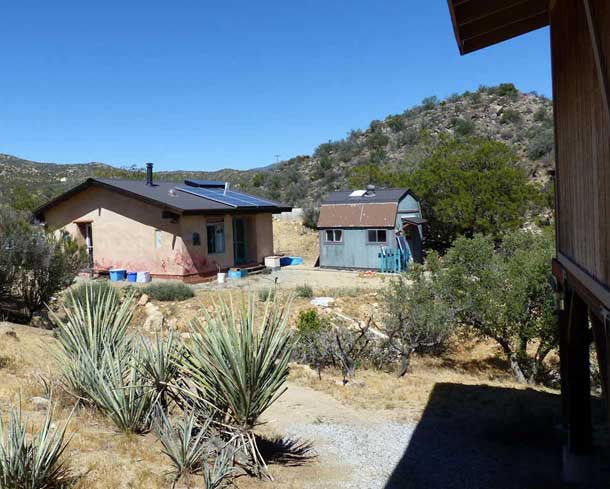
View of home and guest house from behind her main studio in Anza, Ca
Larry: When did you first come here to Anza, California and how did you go about building your home and studio out here in such a remote desert area?
Jane: In 2004 Dorland Art Colony burnt to the ground in a wildfire. Dorland had been my landscape painting refuge from NYC for nearly 20 years. Cabins were considered only a “skin”to separate you from nature while living within her cycles. The Anza land looked like a national park in its sheer beauty, so I spent my sheckles and bought 60 acres where my friends: a painter, a kayak river guide, and a surfer, built a studio for me like one I had at Dorland. The Mojave desert winter proved to be unbearable while living in my studio so I built a small but high tech, solar powered off grid straw bale cabin. It’s very quiet with 2-foot thick straw walls, environmentally friendly but endless work to keep up. That’s my bargain with this magnificent land–to live with it gently and leave a small footprint.
Larry: You recently helped the book The Unpicturelikeness of Pollock, Soutine & Others:Selected Writings & Talks by Louis Finkelstein. come into being. Louis Finkelstein was your late husband and you own many of his paintings. Can you tell us something about why this book is such a great read for painters?
Jane: Louis was a real perceptual painter, and he wrote from his painting experience sifted thru his tremendous classical knowledge of both the history of art and of human culture. He was a renaissance man. He wrote about large ideas, about what he saw, read, experienced and understood. He analyzes art fashions with knifelike, surgical precision. His writing is dense with ideas and insights and may sometimes comes across as difficult because of his passion for particulars and articulation. It is challenging to digest his writings but they yield a painters feast of content that is immediately relevant in the studio. His writings push painters to be the best painters they can be. He believed in the possibilities of the written English language; that thru it we could define our human condition and the language of painting.
![]()
![]()
[For more information on Louis Finkelstein please see links to a LOUIS FINKELSTEIN: THE LATE PASTELS IN THE CONTEXT OF HIS ARTISTIC THINKING a brilliant essay by Martica Sawinon Lori Bookstein Fine Art and the article on Painting Perceptions, Louis Finkelstein, On Painterly From the 06/27/2000 NYT Obituary “…As a critic, Mr. Finkelstein wrote for Artnews and the College Art Journal. He was highly regarded as a teacher both at Queens College, where he worked from 1964 to 1989, and at the Yale University School of Art. He was a regular and popular lecturer at the New York Studio School in Manhattan from 1966 to 1998.”
![]()
![]()
Larry: What was it like to be married to Louis Finkelstein? Can you talk about how he influenced your work?
Jane: Living with Louis was vital, fun, and made me stretch intellectually. We were passionately in love, that never changed. We worked hard at painting everyday all day, and dinners were late and sweet. He was an intrepid chef in his apple green apron, all the while gesturing with forks and knifes while booming out art ideas with his distinctive accented NY voice. At breakfast he gave extensive art history lectures to me at 8am while I was still torpid, or put forth important art ideas on the crowded freeway while I weekly drove us to NYC (he was a rotten driver) from Stillwater NJ, our landscape painting spot. All his waking hours were consumed by painting, reading or writing about art; he never stopped.He taught, painted and wrote with great dedication about seeing the world and its values in terms of painting and its ideas. He lived with the highest of intellectual aspirations and his facial expression was of curiosity when he died.
Larry: You’ve likely been asked this a million times, but what keeps you drawn you to paint these forms for so long?
Jane: I love rocks, I don’t know why.
`
Larry: Living things, like trees, seem to be less visible in your work however your rocks are alive in a different sense.
Jane: They have an active history. They were formed by wind,rain, and by tectonics that push up and crack apart as the rain filters through. And so the West is full of young rocks and young land being formed. The East is full of old used up rocks with trees growing over everything and in your face. So I like the West where I can see what has happened to the earth and what is still happening. I’m totally captivated by this. Why? Because it speaks to me. Because I can look at a rock and feel its history in my body. I’m close to the earth, the sky is over me and huge. When painting, my body is very close to the rocks, the landscape is all quite alive.
Larry: You paint these mysterious, monolithic forms in a rather harsh, barren environment. You live and paint where there are few people around. You’re not painting in a studio or school where lots of other artists around. Why this attraction to solitude?
Jane: I use to love to watch the ants build things in my grandmother’s rock garden. I turned over every rock to see what was going on under it. I still feel the same spellbound curiosity about nature. I cannot get any peace where there’s a bunch of artists fighting with each other. I tried studio painting for years, and I hated it. I hated people around me and making noise. I don’t want to know what they’re doing. I want talk with nature, and if I’m going to spend my time painting, which is hard enough, I’d rather be painting someplace that I love where I can hear my feelings speak. When I moved here, i felt i had moved into my drawings. As Ellen Maloy says in her book, The Anthropology of Turquoise: Reflections on Desert, Sea, Stone, and Sky
“Of all the things I wondered about on this land, I wondered the hardest about the seduction of certain geographies that feel like home—not by story or blood but merely by their forms and colors. How our perceptions are our only internal map of the world, how there are places that claim you and places that warn you away. How you can fall in love with the light.”
Larry: So do you think having the solitude effects the level of your concentration when your working? Do you find that your head is in a different space if you don’t have other people around?
Jane: Yeah, I’m extremely distracted by people. I wish I weren’t. It’s been a bane to my existence. out here I feel in harmony with my surroundings, like birds following me around, watching. I feel quite peaceful here and I don’t know what else to do with life except find a little peace. I certainly can’t change the present world situation much.
Jane: I can help my friends the birds and little creatures by making a wildlife refuge here. Keeping this land wild for them. I think wilderness has its own order and this resonates in my being. I cannot stand an artificial enforced order. When a rock cracks it has a reason for cracking. When a rock is smooth, it has a reason. visual forms that have consequences are vital. Every thrust of movement I see in nature and feel when I’m drawing has a direction, has a consequence because I see it in the landscape in front of me having consequences. I feel it and try to paint that. I can’t feel that in the East with the trees, houses and weeds in my way, they garble my brain.
Larry: The other thing that you mentioned too was the color out here. That the color out here is so important to you versus what’s back East.
Jane: Green, I hate the Eastern green. Back East it’s all fat opulent green which just sits there vegetating and takes up all the space in summer. In spring it’s a chorus of shrieking green. The colors here are elemental, my pigments contain them and they explain how the earth moves. I love the warm reds and oranges of the earth, mysterious in their color layering that follows folds created by tectonics in the earth. The light colored sandy grit of decomposed granite underfoot is the scrubbed remains of rock and then there is that bit of turquoise light that hides within violet shadows…
I think the color here has a lot more individuated character, it fits the forms. The attempted greens of the scratchy little brush are sparse, deep dark with orange umber black in them. I like the shape variety of clouds in the always changing big sky. The West has different clouds than back East, the winds tear and pull at them incessantly fighting for their moisture. Those elliptical clouds formed over the Mojave desert are just killers. They are amazing beings. You can see what’s going on in the weather patterns out here so much easier than back East. Nothing is buried. It’s all obvious. I can’t spend time trying to find where the bottom of a tree comes because there’s a bush in front of me. I don’t want to, and I’m not sure I even want them to overlap. I just want to see the nature of the beast in front of me, the nature of the creature, the nature of the mountain, the tree, the rock, whatever it is. I’m not interested in static patterning and design, instead I’m curious about uncodified irregularity. So it has to be a natural order for me to spin the story. I can’t paint intuitively without movement and natural order.
Larry: Maybe what you’re looking at out there in the desert, these forms, the rocks and everything; it’s almost like they’re containing you. You have this expressive energy with making the art, but these forms help keep everything in check. It’s keeping that expressive power in check, channeling it into responding to what your response is to the desert forms. Perhaps it’s that you are really an abstract expressionist painter that stays within the visual boundaries of what you’re looking at. You’re completely free as long as you stay within these boundaries. If you have unlimited freedom …
Jane: You can’t do it.
Larry: Then there’s no structure. There’s no composition. The thing just sort of falls apart into mush.
Jane: It’s flabby.
Larry: Flabby, good way of putting it.
Jane: It’s true.
Larry: I don’t see your paintings as wanting to be naturalistic, They seem more like a strong expressionistic response to nature. You’re going at it in different ways. Obviously not the same way that Corot, Monet or California plein air painters would do it. Aren’t you painting it more along the expressionistic lines of Soutine or Oskar Kokoschka…?
Jane: To me they are naturalism in a very real sense: I think we are just starting to see Nature for what it is, not as a cooked concept. Ironically, we are seeing Nature just as we are losing Nature. Maybe my paintings look strong and expressive because I try to be one with a sparse and chiseled landscape, but I really am trying to paint what I see, feel and know. I guess the expression comes from the feeling of identifying with natural forces.
Yes, those painters and Titian too, hopefully. Have you ever seen any of Titian’s drawings? How many times he changed them as he worked. First the figure was leaning over the woman and then he moves in toward her, then closer still and then reaches toward…all in the lines of one drawing. His painting are like that too. So I would include Titian with Soutine, I really think they are buddies. And they move. That’s how they do it. Things are moving always in the process of becoming and then they do become alive to us otherwise the painting becomes a static design or a surface pattern.
Larry: I recently heard someone say that bad abstract painting designs and bad representational painting illustrates. You seem to avoid both these pitfalls because of the structure with its rhythm and gestural forces; your color and marks lend a visually poetic sensibility to these paintings.
Jane: I paint intuitively following a rhythm that my eyes feel as they travel thru the space of the landscape. The structure or ordering of forms has to support this rapid movement. So I put the forms on an axis, like I learned to put figures on an axis then I can see them in space and flat too. I do that, or try to because I don’t know any further way to reduce them and their nature, except on an axis.
Everything leans like Cezanne’s ptg. of Madame Cezanne in the Met. To make sculpture more alive, the early Greeks broke the symmetry, this up, that down. Rembrandt’s light and dark masses–part of the form rises, the other part falls. The whole form of a landscape can be treated this way.
If you concentrate to put the thing on an axis, then you do hold onto it and I’m sometimes impetuous, or I can’t or maybe I’ll use the horizon line as an axis…as a set-up. But this is all technical stuff. The painting depends on me striving first to realize the presence of the mysterious character and forces of the landscape and then try to push the conversation. In my best paintings, a particular landscape presented itself as an immediate visual take of emotion, it grabbed me.
Larry: Your work has a great deal of surface texture, are you doing something with the sizing to manipulate the texture of the gesso of the ground to respond to the subject somehow?
Jane: I use a thick oil ground on the isolated masonite board. But yes, I’ve made underpainting bas–relief diagram of the landscape area I was painting with a spatula. This helped me understand the structure of the place. However upon painting directly upon the built up ground I found myself coloring it in. it was repetitive,imprisoning and not inspiring. Years ago I did paint directly the tones seen on my little clay bas relief landscape sculptures to learn.
Jane: Painting and sculpture, they’re two different things. Painting is paint, it’s color, and it’s tone, and you use it as a relief, perhaps, in the way of a relief, but it isn’t relief. It’s painting. They don’t mix: they seem to negate each other. Even the Greek painted sculpture doesn’t quite work. It becomes something else, decorative.
Larry: You like having texture be independent of the actual mark.
Jane: I like the texture of brushstrokes to evidence the process. I find that my marks are primal and articulate. When I’m making a drawing or watercolor trying to comprehend the whole thing, they tend to be large arm movements. I do the same thing when I make the under-structure on the board, so I will find that somehow they work right in. There’s bound to be some analogous rhythm in it, a rhythm that works and guides my gestalt. Under, over, it works. It was just by chance that I found it.
I’m just extremely grateful to have it, because until then I couldn’t feel any substance in my paintings.
Larry: How much time do you spend looking at the subject before you make the mark. What would the ratio of looking to mark making be?
Jane: It depends on where I am. There’s always a moment of silence before I start, where I ground myself and think, decide what’s important. When I’m on residency or in the Mojave desert I would see something very beautiful and it comes on you like a storm. It presents itself. That’s what you’re trying to paint, that initial presence. It’s better to sit and contemplate it a little so you can fully feel it. Nothing else, if you lose sight of that one vision–and it does change, probably immediately. If you don’t get it then you won’t have anything. You can’t get the character of a person unless you get it right away. Time passing just doesn’t allow it.
Larry: So are most of your sittings in a couple, two or three sittings, or one sitting, or does it vary?
Jane: For one quick sitting it will go three or four hours. in the intense Anza Borrego desert heat it has to be that, and I wish it didn’t. Paintings near the studio let me go back and forth 3 or 4 times. In Yosemite National park I have painted several particular motifs over and over thru many years. Joshua Tree is now a drive through park, it’s harder and harder to paint in it.
Larry: Death Valley seems to be just absolutely incredible.
Jane: It’s very incredible, and you think this is hot. Well, Death Valley is really hot, the light is blinding, and its beautiful. It’s hard to remain there very long. I think I was there 10 days and that’s all I could take. I was camping out.
Death Valley is flat in the middle and any standing water is brackish and filled with the salt of distilled heavy minerals, it’s deadly. It’s an amazing place. Even in back country off-road camping there wasn’t any shade, just harsh unforgiving pounding light but there were big rocks and dazzling earth colors.
Jane: Paintings teach you about how to see. Cezanne now there’s one, I still keep looking at him. When I first looked at a reproduction of his watercolor landscape Bend in the Road as a student, I couldn’t figure it out. About six months later, still looking at it–upside down, sideways, with rapid glances backwards. Suddenly one day I looked and it started to fold out like a staircase. Things came out, they just stepped out off the page.
Larry: You seem to paint the similar places over and over again, reminds me a little of Cezanne and his Mont Sainte-Victoire series of paintings…
Jane: Yeah. It’s a landscape legacy. To me, Cezanne made landscape painting into real golem painting. Before that landscapes were usually the background of things. I studied the 17th century Dutch landscape painters for a while along with Cezanne. Dutch paintings are wonderfully dramatic in the light and shadows, the use of the horizon, you feeling apart of the landscape and even the paint.
You can see a mountain so many kinds of ways. The Chinese know it too, the mountain continues to elude you. The author of “Arctic Dreams” writer Barry Lopez says, “Nature eludes you, it changes its mood so quickly you will never be able to define it.” He says you can go out and pick up a leaf or remember the scent of a bush, or see some scat, he says you try to put all these pieces together of the land that you love and hope to define it. He said, “The land will always elude you.” And it does.
Painting is a slow way of seeing. Understanding what you’re seeing.
Larry: But you lived in New York for years, right? So how did you deal with living so far away from your subject?
Jane: Not easily. Louis and I would go out to paint in the Delaware Water Gap in summers. In the winter I would take a month or two off and come to Dorland Mountain Art Colony here in Southern Ca.and do my favorite, western painting.
I would leave him to come out here. Actually when we first got married I had a six month stay at Dorland and I left right after we got married. He had to come out and get me. It was one of the two times he came West..
Larry: He didn’t like it out here?
Jane: No. There’s no trees. His paintings show how he loved trees. He thought the West was awful. We drove days to get to Bryce Canyon, he said with great anger ” I can’t paint here–there is nothing to paint, it’s chaos” and we packed up and left. And he looked at the Grand Canyon and he said, “This is like Hell! I can’t imagine walking down there, it’s frightful.” He hated it. He did some nice work in Zion National Park and Yosemite. We had a good time, but we never came back. He would say in Yosemite how much he liked it and his paintings showed this and he did make some lovely pastels. Then he’d get back and he’d bad mouth the west. It was funny.
Larry; A true New Yorker.
Jane: He grew up there, he called himself a “child of the Met”.
Larry: What did you think of the Bay area figurative painters?
Jane: I thought they were very painterly. I love Diebenkorn, Park, Bischoff. I particularly love early Diebenkorn’s landscapes and Oakland museum has a dynamite collection of many early Bay Area landscape painters.
Larry: They do. I saw that a little while ago. They have a great collection, David Park, Joan Brown.
Jane: Have you ever heard of Hassel Smith ?
Larry: No, I’m not familiar.
Jane: He was a landscape painter. He make these graphic, abstract landscapes around Diebenkorn’s time or a little before. There was a Bay Area group of landscape painters then. They were experimental; they tried to do the abstracted landscapes with an eye toward still life composition.
Larry: Didn’t most of them paint urban scenes or figurative? I don’t remember seeing that many pure landscape like what you’re doing.
Jane: Whats “pure”?. Concern with keeping the landscape topography and character of primary concern? …early Diebenkorn painted experimental landscape..
Larry: Early Diebenkorn was?
Jane: Still landscape. Beautiful, magnificent paintings. they were the Berkeley hills and landscape concerns later continued thru his big light filled last paintings…the Ocean Park Series.
Larry: Oh right, the Berkeley Hills.
Larry: He was painting from observation then or was he studio??
Jane: He painted from observation then, thru the windows and remembering. He was working from his abstract thoughts too.
Jane: He looked a lot at Early Rothko I think. And then Hans Hoffman, I think he was influenced, they had a big Hoffman collection in Berkeley.
Larry: Would you say that Hans Hoffman is someone that was an influence on you?
Jane: I did look at his paintings. As a teacher, he was too strong. Louis never studied with him because he felt he would be too influenced by Hoffman, but some people did like Mercedes Matter did, I think.
[please see the highly relevent Frank Hobbs blog post that reproduces Mercedes Matter essay from a 1973 NY Times article on How Do You Learn to Be an Artist? where she talks about drawing, Plasticity in art, Hans Hoffman and more]
Larry: Did you? Did you study with Hoffman?
Jane: No, I’m not that old.
Larry: You’re not that old. I get the timeline mixed up. I knew you were in graduate school at Yale in the early 60’s, so he wasn’t teaching then?
Jane: Louis was teaching, I was his student.
Larry: Hoffman wasn’t teaching then?
Jane: No, Hoffman was not teaching at Yale then. I think he was in Provincetown. He might have been out there teaching. Mercedes grew up knowing Hoffman thru her father, Arthur Carles
Larry: Now I read that one of Louis’ teachers was Edwin Dickinson, is that right?
Jane: Louis put a book together for him at Yale. He proofed the plates. He made sure the color was right for him on it.
Larry: They have such different approaches.
Jane: Yeah. Well Louis liked different; he liked particularly artists who were good and were successful. Success influenced him, And yes, he really liked Edwin Dickinson. He liked Wolf Kahn too. Because he was successful. He admired success, that get up and go. Who else did he like? Oh a lot of painters. Always the masters, he could tell you anybody’s painting and he’d know where each painting was in what museum. In just about what room.
Larry: He was also really pushing painting from observation when that was a really radical thing to be doing back then. I mean very few people were thinking about that in a modernist way. Back then.
Jane: Yeah, well it was the abstract expressionist time and he continued to paint representational. He did dabble a little, I saw some good early abstract paintings and sculptures of his.. but he always returned to paint from life. He believed in it.
Larry: Back then, it was probably unheard of to have a teacher talking about painting from life, like what Louis Finkelstein was doing. It just seemed so out of step with what other people were doing back then.
Jane: Yeah, a certain period that was true. A period in this country.
Larry: Why is painting is having such a hard time holding on in the art world these days?
Jane: First of all, What art world? You must be referring to the Art Market of commerce and fashion. Painting is a slow way of looking, it’s thoughtful. When was that of value? Everyone is in a hurry, they don’t want to think. Career artists don’t want to develop a vision, they want a style. Especially the young painters in graduate school. They don’t even know what a vision is. They think they are born with this talent that makes them great or makes them hot. This is not a vision, more often it’s fashion. You have to know and love the tradition of the language of painting and want to keep that tradition alive with your own vision. Like the medieval monks keeping the art of writing and reading alive during the dark ages. Most likely, you have to work years for a painting vision ; you’ll get more cranky and more vision as you get older. It distills.
Larry: I’ve heard a few people say that it used to be that the painters getting out of art school would basically go into seclusion and not show for many years, just paint. Maybe show a few friends but they wouldn’t really show or promote their work until they the work felt solid and right. Often now students want to show as soon as they get out of school, or even while they’re in school. Wanting instant gratification.
Jane: I thought, you know after 50 years of painting, it will get easier. It doesn’t. For me, painting doesn’t seem to get more facile. Maybe for some people it does. Louie’s got better towards the end. I think you get better if you just keep working at it. You just have to work work work, and then you have to let loose, just like life. When you’re talking about getting into the zone, you’re letting loose of the control.
Larry: It is paradoxical that sometimes in order to really lose control and get into that zone of being unselfconscious; you have to increase the control of your looking, to heighten your attentiveness.
Jane: Absolutely! It’s tricky business. Hopefully when you’re painting, you’re not thinking these things, you’re just going after what you see, which is good reason to paint perceptually-to stop the chatter.
Larry: We were talking earlier on the way here about the idea of plasticity in painting.
Jane: Oh yeah, bad word, but it’s such a good idea.
Larry: What is the definition for you?
Jane: Louis’ definition of it was that “Plasticity is the expression of volume–not simply a description of three-dimensionality, but volume as the primary standard of thematic coherence and meaning. When he spoke of Wagner’s music as “sounding forms in space” critic Eduard Hanslick was talking about something similar… Volume or “voluminosity”–the character of having volume–is to me the most global and rigorous standard by which the integration of a picture might be measured. It is also the most expressive property of a picture. It carries with it a sense of our own bodies, along with other bodies, in the physical world. It is the basis of all imagination.”
My definition is when every part and element works with and is conscious of each other in the whole painting and there is some sort of consequence and movement to this, so a painting is vital and alive.
Illusion is not experiential and when you are painting illusion, you are usually painting a conventional idea. You’re painting only an idea of what you’re seeing. It’s prosaic. You’re being literal about something. You’re not being poetic with many levels of interpretation of meaning.
Larry: I’m not sure I follow.
Jane: Well it is if you are locked into the idea of foreground, middleground, and background.
Larry: Oh I see.
Jane: With an idea that that is indeed possible. It’s not what your eyes are seeing. It might be your experience when you walk, but that’s an idea that the Renaissance gave you.
Larry: Right, right.
Jane: It’s a nice way of ordering the teeming landscape.
Larry: It’s a construction to make a painting. It’s one way to do it
Larry: That doesn’t necessarily mean, using some sort of system of perspective, like one point perspective or whatever. It could just mean, you could do it in a very general way, like Corot, a landscape that he would do, would have very clear definitions of space and boundary.
Jane: Yeah but wasn’t he trying to paint what he saw?
Larry: Yeah. He wasn’t following a system particularly, but he did have foreground, middleground, and background.
Jane: it’s a good clarifying and ordering principle, I could certainly use more of it.
Larry: What I meant more was, like your paintings, I think there is a plasticity, but it’s seeing the painting as a whole unit. It’s more of its abstract qualities that it has this sort of …
Jane: You have to see the whole thing.
Larry: It’s different than illusionistic space. It’s a different …
Jane: You’re participating on, like you say, a flat level at the same you’re participating in depth, and when Hoffman said … When they talked about the picture plane flattening depth into the picture plane, bringing all the depth into that action.. When you squash your depth that has been experienced into the picture plane, you’re bringing a large energy into that squash, because there’s all that room that you’re squashing. It has a force that a flat painted plane won’t ever have, and probably a plasticity that it won’t have either. When I think from looking at Mondrian’s trees and then into what he went into eventually, he kept that. Remember his trees?
Larry: Sure
Jane: How much space in between each branch? How much volume and tension there was? I think if you don’t bring it to the surface somehow in your own history in time, it’s not going to be there. You don’t just start painting flat. I think that’s why Robert Rauschenberg and Jasper Johns are who they are. I think they’re just glorified commercial artists, and I’ve always believed that. I think they’re very good, I think they’re very tasty. There’s a lot of physicality and stuff that humans like. It’s delicious, but I don’t think that they have that compression, I don’t think they have that tension in their work. I never have thought that. I think no matter how fast you move your arm, you’re still not going to necessarily get it. I think that’s where the splits started. We highly value perceptual painting, I think they didn’t work from perception. They took objects from the world around them and plastered that onto the painting, but that’s not perceptual painting, nor do they have volume.That’s not running it through your mind as something, your experience, above all, and your feelings, judgments and your calls, those are hard. Those painters don’t risk. No risk. The outcome of the painting was already cooked; it was a done deal.
Jane: Plasticity!! That word again.If it had been any other word, it might have taken off . People have said that over and over. He just chose the wrong word. One night we all sat together and tried to think of a word and we couldn’t think of one. I think we were all having dinner at Irving Kriesberg’s and were talking about it.
Larry: Do you think they’re talking about plasticity in the art schools today? I wonder if it is even on the radar of most people?
Jane: Not at all. People have no idea that kind of coherence in paint even exists. It’s too bad. It’s such a loss. It really is exciting. I find it all very exciting but god knows they don’t have a clue. If you can’t read the visual language of painting you can’t feel it. I think of perceptual painting as a way to keep the language of painting alive, like the monks scribing during the middle ages keeping books alive.
How a painters eyes see..They used to teach like that a long time ago. I think Irving Kreisburg wrote a book like that ( http://www.amazon.com/Irving-Kriesberg/e/B001HP6BQE) and other people have too.
Jane: Do you know Irving Kreisburg? http://irvingkriesberg.com/index.html
Larry: No.
Jane: He’s such an expressive , humorous, generous painter. You don’t know him? He died about 10 years ago. Good painter, he did nice big rich colorful physical paintings of animals and white owls .. but they were symbols of animals, they were patterned but plastic. They were very expressionist, abstract expressionist. I adored his painting. I’ve got a pastel of his somewhere. He was just the best guy. He was an old Jewish hippie who married a Palestinian and he brought that mentality. He was this encompassing man. It wasn’t that he adored animals, he came from the freedom and cartoon orientated painting of the Chicago school. He’s a really good painter, but you don’t hear about it. Just like George McNeil.(http://www.amy-nyc.com/artists/george-mcneil
Larry: I was at an art event recently where someone was lecturing on the importance of painting as a vehicle for social change. However, to me it sounds more like wishful thinking, I just don’t see many political views being changed by paintings. I suspect most people who attend art shows are already predisposed to thinking more about social change. Political-themed paintings are more likely to just be preaching to the art choirs. However, on an aesthetic level maybe you get people to appreciate a new way of looking at our world. Maybe some people will be moved by a painting enough to slow down more to appreciate an new, previously unknown aspect of beauty. Maybe it gives new incentives for making the world worth saving…
Jane: It’s more often the other way around that the artist is the mirror, the vibration of the society around him. The political artists and their viewers are not changing, they’re simply presenting and acknowledging, “Here it is, this what’s going on,” whether you like it or not. Changing, no, maybe one person. I have made a lot of political art for demonstrations and it is just cathartic in the end. I know of a couple of people who changed because of my landscape work, but they also were able to change and learn more about painting. That had nothing to do with my work. They were open to it, with this direction instead of that direction, little bits. Little bits and little tweaks, that’s about it. It certainly does promote enjoyment of their senses and opens their senses and their questioning and things like that. It keeps their minds open, open enough to look in the first place. IF they possess the mind to do that, if they want to learn.
Larry: I worry that the knowledge about what makes great paintings great is gradually being lost. Schools aren’t really teaching it and few really promote it in a big way. Good painting is not selling as well as it used to be. More and more people seem to be unable to differentiate between good and bad painting. I know this is vague but I worry for the future of painting. Of course there are many terrific painters out there but it increasingly seems difficult for them to make a living doing this. Difficult to show work many times and even more difficult to sell. Even teaching to support yourself is very hard.
Jane: The planet is dying and the people are crazy. So how can anyone distinquish good painting? I know Louis used to say that there weren’t very many people that knew painting in the first place when he was alive. He also said, “If I went into painting to make a living, I would never have gone into painting.” It was not expected to make a living off painting. It was not part of it. It was a vocation. It was something you aspired to like meditation to make yourself better, to understand more of the world like a scientist. It wasn’t commercial art it was fine art. Galleries now expect you to bring a following of buyers to them as part of the deal.. so their connections and sales must be iffy. The large art fairs and online art sites are hurting them financially.
Larry: The booby prize for destitute painters is that you get to enjoy your life. Having a good life doing what you love.
Jane: Its an existential prize. ..Then we shouldn’t worry about it, should we? We should just go ahead and paint because that’s what we love to do. Furthermore, we don’t have a choice because that’s what we had to do. I don’t think I ever had a choice. After I was about four or five I stopped having a choice, I just had to draw. Probably you were too maybe without knowing it. That’s just the way it is. I just wish we could convince more people that it’s a good way to go, really a good way to live your life. I have taught art to isolated elderly and disabled adults and troubled children, and doing painting has turned many of their unhappy lives into joy.
Luckily, I’ve known a couple of collectors . Sadly their houses are overloaded with my stuff now. There are many collectors that can see well enough to buy your work but they’re very hard to find as your time and venues are limited. In my case, they tend to love the wild landscape and be contemplative people. But they are there. Sometimes they see your work somewhere and contact you. It isn’t over until it’s over.
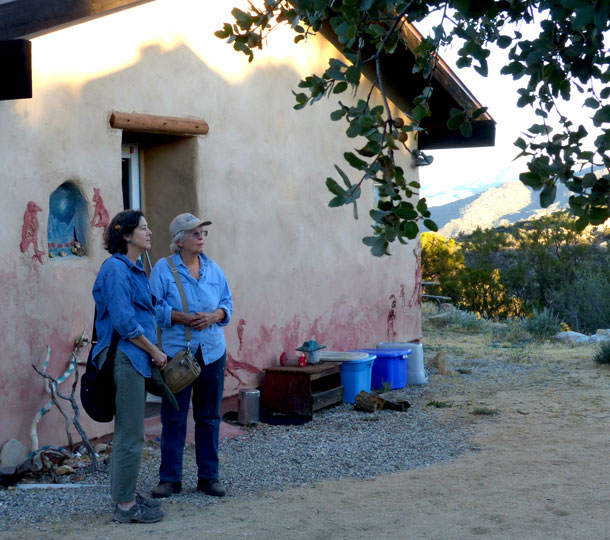
Jane Culp and Celia Reisman at Jane Culp’s home

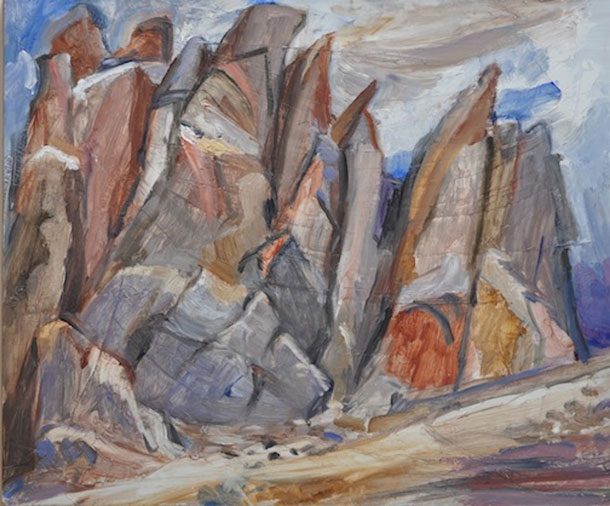
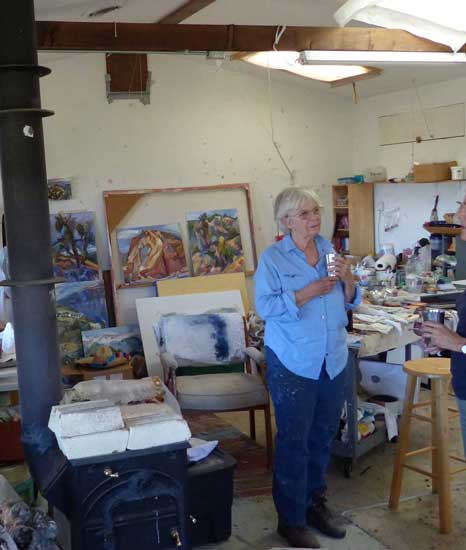
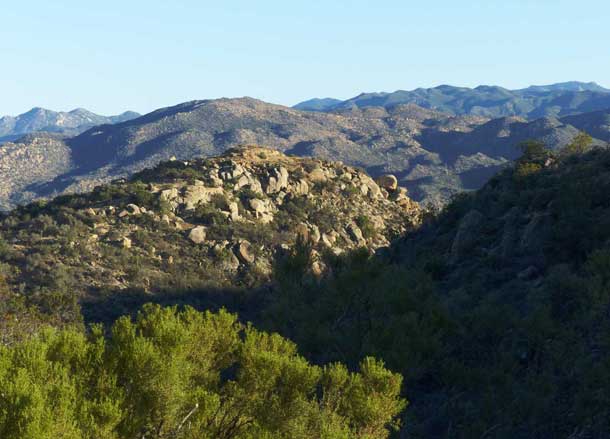
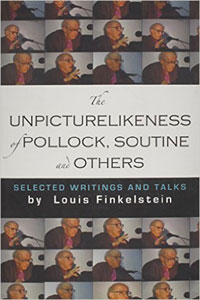
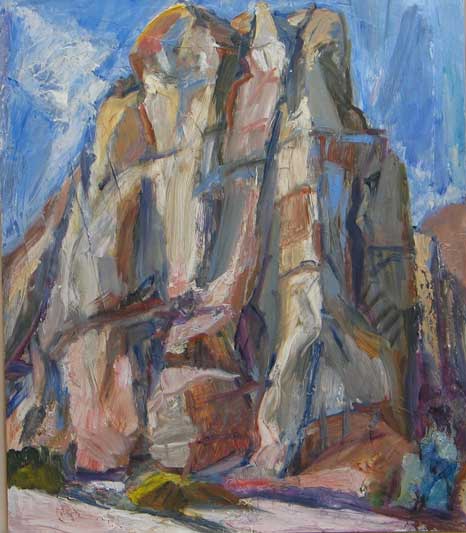
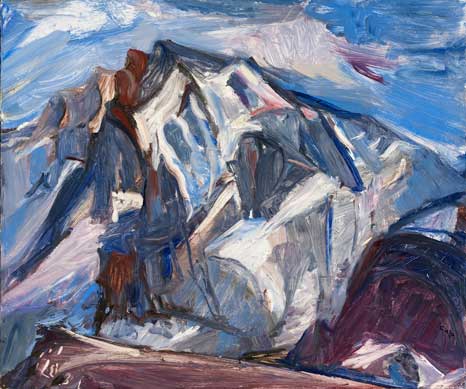
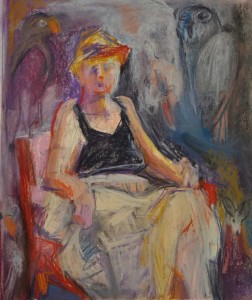
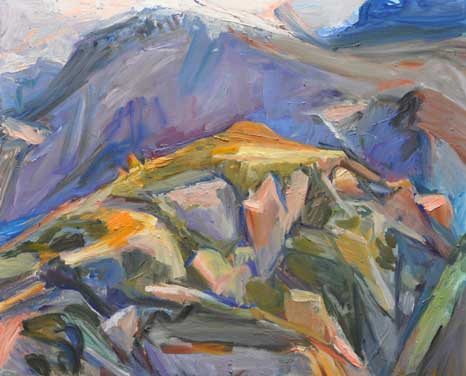
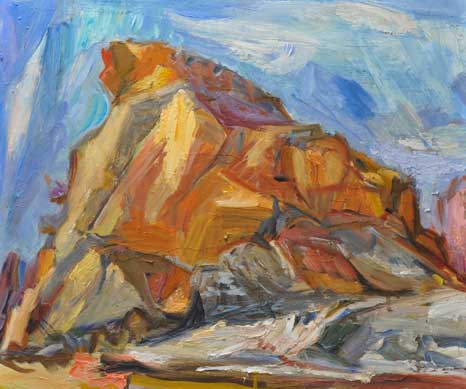
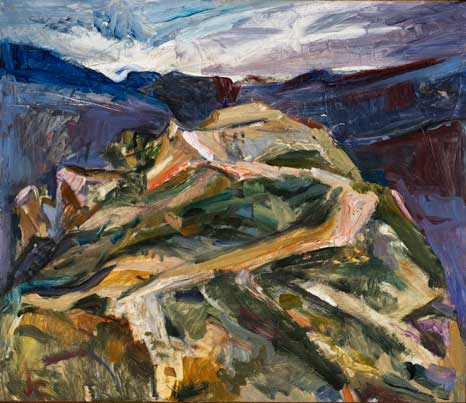
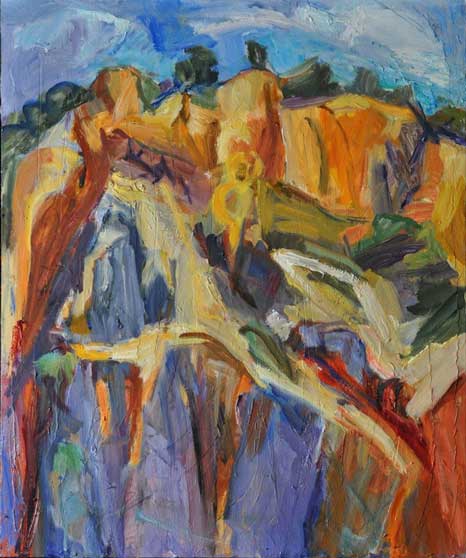
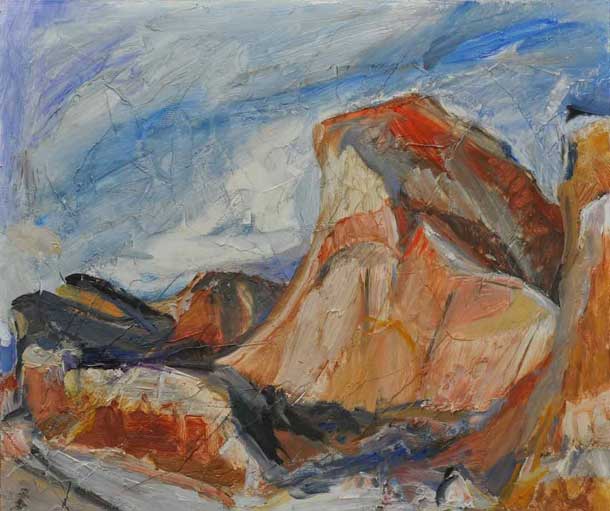
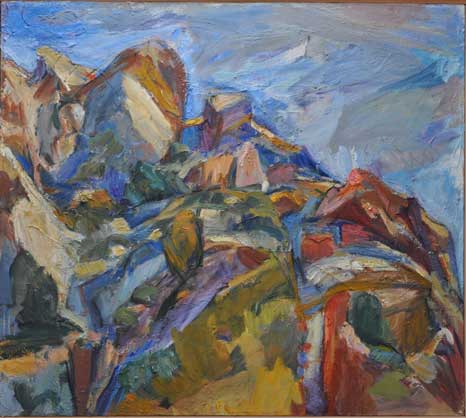
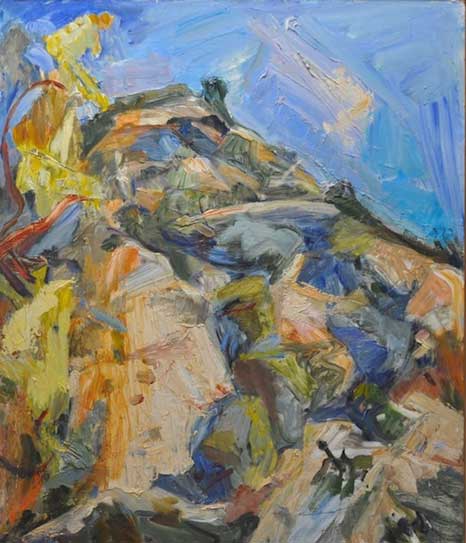
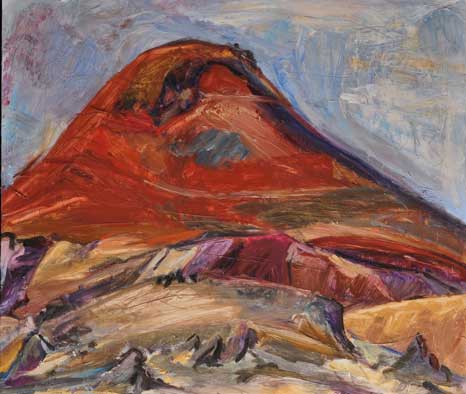
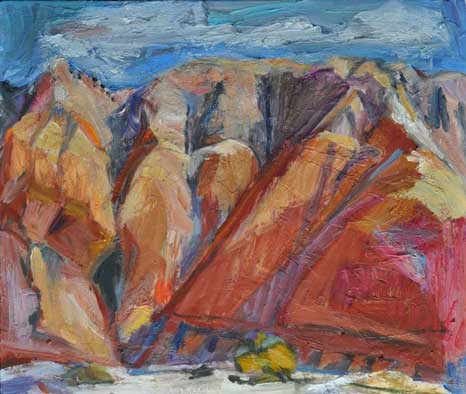
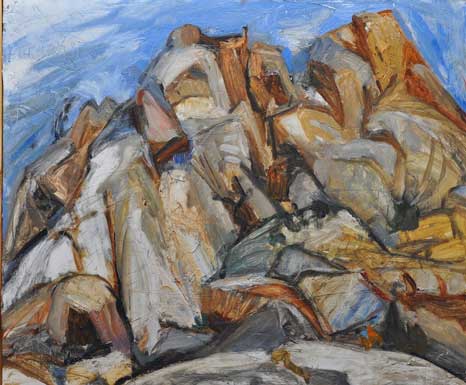
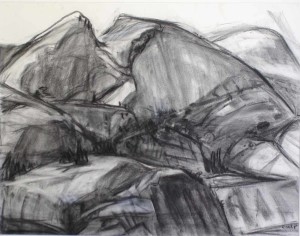
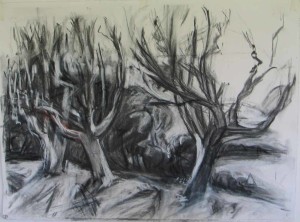
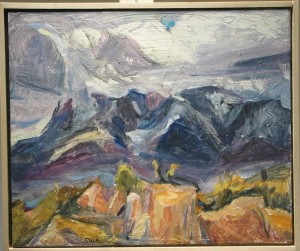
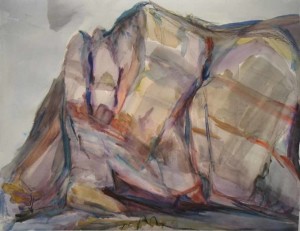
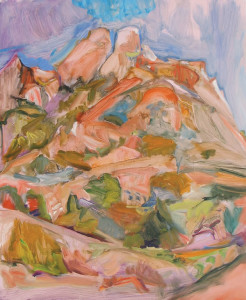
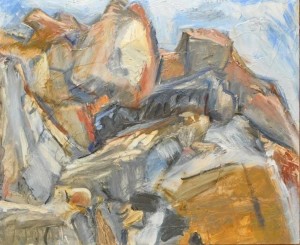
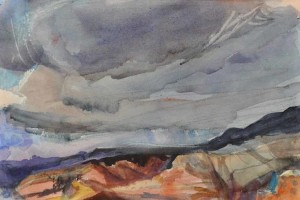
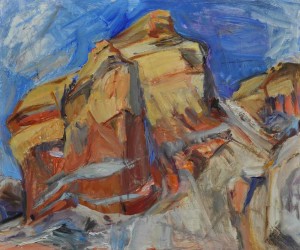
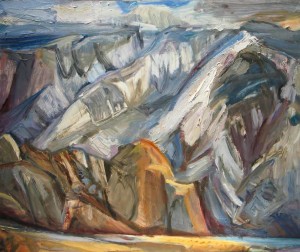
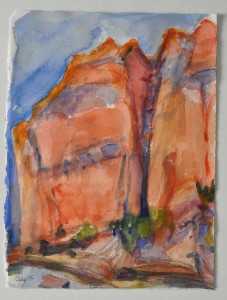
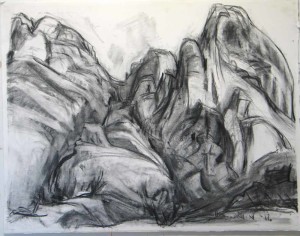





These are wonderful paintings and I am grateful for the unselfish and honest reflections on your life and work.
Quoting from you:
‘if I’m going to spend my time painting, which is hard enough, I’d rather be painting someplace that I love where I can hear my feelings speak. When I moved here, I felt I had moved into my drawings.’
Addressing how places claim you, in a youtube interview ‘Richard Diebenkorn on Beginning a Painting’ says: “Very often if you go the locale where an artist works, you’ll suddenly know that you’re in this person’s area.” (It’s satisfying to hear Diebenkorn’s voice in this interview.)
https://www.youtube.com/watch?v=PV1ZHh9wl7
Thank You for your comments, Ginnie. i love Diebenkorn’s landscape
paintings.
Yes, I love his ‘Berkeley’ series
Oops! Here’s a better link to the Diebenkorn interview on youtube:
https://www.youtube.com/watch?v=PV1ZHh9wl7w
I’m about a foot off the ground after having read this piece and studied the paintings. Like Jane Culp, I love rocks, from pebbles on the beach to the mountains they came from, rocks — and water– are the underpinnings of landscape and life for me.
Thank you Larry — this is an excellent conversation and I appreciate the length, breadth and depth as well as the introduction to an artist I didn’t know.
Oh, Jane, I’m no visual artist, or art critic, or art student, or even well informed. But I LOVED reading this illuminating interview and seeing these photos of your work. I’m transported back to the times when I saw your studio and its immediate landscape, to the power and ecstasy that radiates there–and around your work. I’m in awe now, as I was then. Sending you great appreciation and love, Esther.
Very wonderful to see your paintings, Jane.
Love the blues. Remember out batik lessons with Mr. Roy? I think of both of you sometimes. Your house is interesting. Nice also to see the photos of you. I just took an abstract watercolor class.
Jane has shared her passion for painting with us and her work has an immediacy and vitality that derives from her being in the place she loves
I treasure the drawing we have of Jane’s and the late pastels of Louis too
Louis was a big influence on my thinking from his writing and his Thought on the Painterly clarified thoughts I had about my own work in the early 1970’s
Thanks to Jane the collected essays was published so these ideas can be shared and considered long into the future
This was like making a personal visit to Jane’s
Thanks